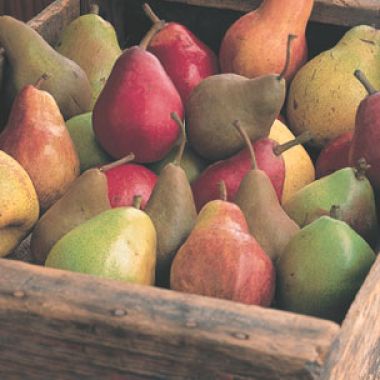
Anjou
An almost egg-shaped pear with green skin, Anjou often displays a yellow tinge even when ripe, although a rarer red variety blushes to reddish green. A ripe Anjou is juicy yet keeps its shape when sliced for salads, cooked in desserts or baked whole. In season from October to May.
Bartlett
Known as Williams pear in Europe, Bartlett has thin skin that ripens from dark green to light green and then yellow. Its aromatic, slightly musky flesh is very soft when ripe. This is a good eating and all-purpose cooking pear. The sturdier red Bartlett is not always as juicy. In season from August to November.
Bosc
Bosc is a versatile pear with a long, tapered neck, green skin with distinct brown russeting, and sweet creamy white flesh. It is excellent for eating fresh and for baking and poaching. Eat Bosc pears when they yield only slightly to finger pressure. In season from September to May.
Comice
Widely available, Comice is the best pear for eating out of hand, with sweet, meltingly juicy, "buttery" flesh and a hint of spiciness. It is quite round, with hardly noticeable shoulders, and its greenish yellow skin blushes to a soft red. It also bakes well. Because it is fragile, the Comice is not a good traveler. In season from October to January.
Seckel
Among the smallest of pears, Seckel is ideal for making preserves. It has smooth, dark green skin with reddish hues and firm, slightly granular flesh. In season from August to January.
Winter Nellis
A short pear with almost no neck, winter Nellis has a brownish green peel with russeted dots. The slightly spicy flesh is enjoyed raw, holds its shape well when baked and poached, and is good for preserving. In season from November to May.
An almost egg-shaped pear with green skin, Anjou often displays a yellow tinge even when ripe, although a rarer red variety blushes to reddish green. A ripe Anjou is juicy yet keeps its shape when sliced for salads, cooked in desserts or baked whole. In season from October to May.
Bartlett
Known as Williams pear in Europe, Bartlett has thin skin that ripens from dark green to light green and then yellow. Its aromatic, slightly musky flesh is very soft when ripe. This is a good eating and all-purpose cooking pear. The sturdier red Bartlett is not always as juicy. In season from August to November.
Bosc
Bosc is a versatile pear with a long, tapered neck, green skin with distinct brown russeting, and sweet creamy white flesh. It is excellent for eating fresh and for baking and poaching. Eat Bosc pears when they yield only slightly to finger pressure. In season from September to May.
Comice
Widely available, Comice is the best pear for eating out of hand, with sweet, meltingly juicy, "buttery" flesh and a hint of spiciness. It is quite round, with hardly noticeable shoulders, and its greenish yellow skin blushes to a soft red. It also bakes well. Because it is fragile, the Comice is not a good traveler. In season from October to January.
Seckel
Among the smallest of pears, Seckel is ideal for making preserves. It has smooth, dark green skin with reddish hues and firm, slightly granular flesh. In season from August to January.
Winter Nellis
A short pear with almost no neck, winter Nellis has a brownish green peel with russeted dots. The slightly spicy flesh is enjoyed raw, holds its shape well when baked and poached, and is good for preserving. In season from November to May.
Adapted from Williams-Sonoma Kitchen Companion,
(Time-Life Books, 2000).












